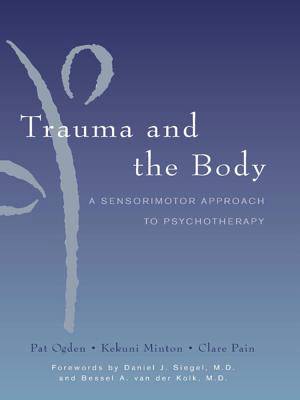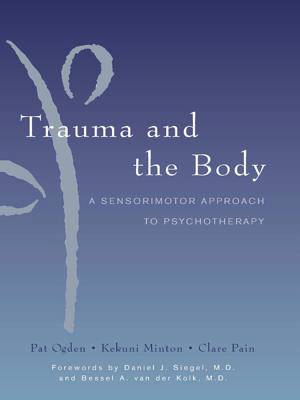
- Afhalen na 1 uur in een winkel met voorraad
- Gratis thuislevering in België vanaf € 30
- Ruim aanbod met 7 miljoen producten
- Afhalen na 1 uur in een winkel met voorraad
- Gratis thuislevering in België vanaf € 30
- Ruim aanbod met 7 miljoen producten
Zoeken
€ 93,95
+ 187 punten
Omschrijving
Psychotherapists who have been trained in models of psychodynamic, psychoanalytic, or cognitive therapeutic approaches are skilled at listening to the language and affect of the client. They track the clients' associations, fantasies, and signs of psychic conflict, distress, and defenses. Yet while the majority of therapists are trained to notice the appearance and even the movements of the client's body, thoughtful engagement with the client's embodied experience has remained peripheral to traditional therapeutic interventions. Trauma and the Body is a detailed review of research in neuroscience, trauma, dissociation, and attachment theory that points to the need for an integrative mind-body approach to trauma. The premise of this book is that, by adding body-oriented interventions to their repertoire, traditionally trained therapists can increase the depth and efficacy of their clinical work. Sensorimotor psychotherapy is an approach that builds on traditional psychotherapeutic understanding but includes the body as central in the therapeutic field of awareness, using observational skills, theories, and interventions not usually practiced in psychodynamic psychotherapy. By synthesizing bottom-up and top down interventions, the authors combine the best of both worlds to help chronically traumatized clients find resolution and meaning in their lives and develop a new, somatically integrated sense of self.
Topics addressed include: Cognitive, emotional, and sensorimotor dimensions of information processing - modulating arousal - dyadic regulation and the body - the orienting response - defensive subsystems - adaptation and action systems - treatment principles - skills for working with the body in present time - developing somatic resources for stabilization - processing
Topics addressed include: Cognitive, emotional, and sensorimotor dimensions of information processing - modulating arousal - dyadic regulation and the body - the orienting response - defensive subsystems - adaptation and action systems - treatment principles - skills for working with the body in present time - developing somatic resources for stabilization - processing
Specificaties
Betrokkenen
- Auteur(s):
- Uitgeverij:
Inhoud
- Aantal bladzijden:
- 384
- Taal:
- Engels
- Reeks:
Eigenschappen
- Productcode (EAN):
- 9780393704570
- Verschijningsdatum:
- 1/09/2006
- Uitvoering:
- Hardcover
- Formaat:
- Ongenaaid / garenloos gebonden
- Afmetingen:
- 169 mm x 241 mm
- Gewicht:
- 725 g

Alleen bij Standaard Boekhandel
+ 187 punten op je klantenkaart van Standaard Boekhandel
Beoordelingen
We publiceren alleen reviews die voldoen aan de voorwaarden voor reviews. Bekijk onze voorwaarden voor reviews.











